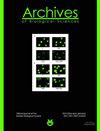Modeling water hyacinth growth dynamics
IF 0.8
4区 生物学
Q4 BIOLOGY
引用次数: 1
Abstract
This study aimed to evaluate the biomass growth of water hyacinth (Eichhornia crassipes [Mart.] Solms) under partially controlled conditions during a 70-day test using a mixture of municipal wastewater and water from a shaft as a source of nutrients. The water hyacinth in a moderately continental climatic condition at a latitude of 43oN can achieve productivity of an average of 18.25 kg/m2 in partially controlled conditions, whereas under natural conditions and under conditions of controlled harvesting, larger amounts of biomass can be obtained. Considering the large amounts of biomass of over 1.5 t/ha per day, i.e. over 180 t/ha per year, produced, water hyacinth can be successfully used in wastewater treatment plants with very favorable economic effects if the biomass generated is used for energy production, as a nutrient or food, and for many other needs. The following models were used to model the dynamics of water hyacinth biomass growth: the exponential model (average MSE 0.3117, average R2 to 0.9793), second-order polynomial model (average MSE 0.0952, average R2 0.9937) and logistic model (average MSE 0.0508, average R2 0.9966). All models have high accuracy; however, the exponential model and the second-order polynomial model give a continuous increase in biomass over time, practically to infinity, without taking into account that under conditions of increased plant density and reduced availability of resources, biomass growth slows down, and therefore, they are not suitable for application in real conditions. The logistic model (average environmental capacity 18.25 kg/m2, average growth rate 0.0571 g/g?day after about 150 days) adequately describes the growth of water hyacinth biomass with high accuracy, which enables the monitoring and control of the process operation and the achievement of the required quality of the treated wastewater.模拟水葫芦生长动态
本研究旨在评价水葫芦(Eichhornia crassipes [Mart.])生物量的增长。[Solms])在部分受控的条件下进行了为期70天的试验,使用市政废水和竖井水的混合物作为营养来源。在纬度43oN的中大陆性气候条件下,水葫芦在部分控制条件下的平均产量为18.25 kg/m2,而在自然条件和控制采收条件下,可获得更大的生物量。考虑到每天生产超过1.5吨/公顷的大量生物质,即每年超过180吨/公顷,如果所产生的生物质用于能源生产,作为营养物质或食物,以及许多其他需求,水葫芦可以成功地用于废水处理厂,具有非常有利的经济效果。采用指数模型(平均MSE 0.3117,平均R2 ~ 0.9793)、二阶多项式模型(平均MSE 0.0952,平均R2 0.9937)和logistic模型(平均MSE 0.0508,平均R2 0.9966)对水葫芦生物量生长动态进行建模。所有模型精度高;然而,指数模型和二阶多项式模型给出了生物量随时间的连续增长,几乎达到无穷大,而没有考虑到在植物密度增加和资源可用性降低的情况下,生物量增长会减慢,因此不适合在实际条件下应用。logistic模型(平均环境容量18.25 kg/m2,平均增长率0.0571 g/g?天后约150天)充分准确地描述了水葫芦生物量的生长情况,从而能够监测和控制工艺操作并达到处理废水所需的质量。
本文章由计算机程序翻译,如有差异,请以英文原文为准。
求助全文
约1分钟内获得全文
求助全文
来源期刊
CiteScore
1.40
自引率
0.00%
发文量
25
审稿时长
3-8 weeks
期刊介绍:
The Archives of Biological Sciences is a multidisciplinary journal that covers original research in a wide range of subjects in life science, including biology, ecology, human biology and biomedical research.
The Archives of Biological Sciences features articles in genetics, botany and zoology (including higher and lower terrestrial and aquatic plants and animals, prokaryote biology, algology, mycology, entomology, etc.); biological systematics; evolution; biochemistry, molecular and cell biology, including all aspects of normal cell functioning, from embryonic to differentiated tissues and in different pathological states; physiology, including chronobiology, thermal biology, cryobiology; radiobiology; neurobiology; immunology, including human immunology; human biology, including the biological basis of specific human pathologies and disease management.

 求助内容:
求助内容: 应助结果提醒方式:
应助结果提醒方式:


